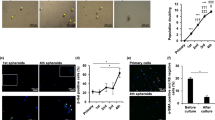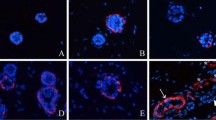Summary
Human sweat duct cells from the coiled reabsorptive segment have been cultured successfully, free from fibroblasts, in a low serum, hormone-supplemented medium. Ham's F12. The cultured cells exhibited a typical epithelial cobblestone pattern and microvilli-covered luminal cells were seen joined together with typical junctional complexes. In cultures derived from normals and patients with cystic fibrosis (CF), growth and morphologic characteristics were indistinguishable. When grown on a membranous support, and mounted in an Ussing chamber, vectorial electroconductive ion-transport could be identified. The epithelial preparations produced active mucosa to serosa-directed sodium flux via amiloride-sensitive, apical sodium channels and ouabain-sensitive sodium pumps located in the basolateral membrane, which also contained a potassium shunt. These findings are consistent with a polarized epithelium with properties similar to the intact organ. High transepithelial resistance and increased amiloride sensitivity were typical for cells derived from CF, indicating that principal normal as well as pathologic properties of the sweat duct are preserved in culture.
Similar content being viewed by others
References
Cereijido, M.; Rotunno, C. A.; Robbins, E. S., et al. Polarized epithelial membranes produced in vitro. In: Hoffman, J. F., ed. Membrane transport processes, vol. 1. New York: Raven Press; 1977:433–461.
Misfeldt, D. S.; Hamamoto, S. T.; Pitelka, D. R. Transepithelial transport in cell culture. Proc. Natl. Acad. Sci. USA 73:1212–1216; 1976.
Handler, J. S.; Steele, R. E.; Sahib, M., et al. Toad urinary bladder in cell culture: maintenance of epithelial structure, sodium transport and response to hormones. Proc. Natl. Acad. Sci. USA 76:4151–4155; 1979.
Bisbee, C. A. Prolactin effects on ion transport across cultured mouse mammary epithelium. Am. J. Physiol. 240:C110-C115; 1981.
Ussing, H. H.; Zerahn, K. Active transport of sodium as the source of electric current in the short-circuited isolated frog skin. Acta Physiol. Scand. 23:110–127; 1951.
Thaysen, J. H.; Schwartz, I. L. Excretion of sodium and potassium in human sweat. J. Clin. Invest. 35:114–120; 1956.
Di Sant'Agnese, P. A.; Darling, R. C.; Perera, G. A., et al. Sweat electrolyte disturbances associated with childhood pancreatic disease. Am. J. Med. 15:777–784; 1953.
Sato, K. The physiology, pharmacology and biochemistry of the eccrine sweat gland. Reviews of physiology, biochemistry and pharmacology. 79:51–131; 1977.
Quinton, P. M. Chloride impermeability in cystic fibrosis. Nature 301:421–422; 1983.
Schulz, I.; Ullrich, K. J.; Fromter, E., et al. Micropunction und elektrische potential messung an sweissdrusen des menchen. Pflug. Arch. 284:360–372; 1965.
Pedersen, P. S. Primary culture of epithelial cells derived from the reabsorptive coiled duct of human sweat glands. IRCS Med. Sci. 12:752–753; 1984.
Pedersen, P. S.; Larsen, E. H.; Hainau, B., et al. Trasepithelial ion transport in sweat duct cell cultures derived from normals and patients with cystic fibrosis. Med. Sci. Res. 15:1009–1016; 1987.
Munger, B. L. The ultrastructure and histophysiology of human sweat glands. J. Biophys. Biochem. Cytol. 11:385–402; 1961.
Yankaskas, J. R.; Cotton, C. U.; Knowles, M. R., et al. Culture of human nasal epithelial cells on collagen matrix support. Am. Rev. Respir. Dis. 132:1281–1287; 1985.
Cereijido, M.; Robbins, E. S.; Dolan, W. J., et al. Polarized monolayers formed by epithelial cells on a permeable and translucent support. J. Cell. Biol. 77:853–880; 1978.
Widdicombe, J. H.; Welsh, M. J.; Finkbeiner, W. E. Cystic fibrosis decreases the apical membrane chloride permeability of monolayers cultured from cells of tracheal epithelium. Proc. Natl. Acad. Sci. USA 82:6167–6171; 1985.
Cotton, C. U.; Stutts, M. J.; Knowles, M. R., et al. Abnormal apical cell membrane in cystic fibrosis respiratory epithelium. J. Clin. Invest. 79:80–85; 1987.
Guggino, S. E.; Guggino, S. E.; Green, N., et al. Blocking agents of calcium-activated K+-channels in cultured medullary thick ascending limb cells. Am. J. Physiol. 252:C128-C137; 1987.
Bisbee, C. A. Prolactin effects on ion transport across cultured mouse mammary epithelium. Am. J Physiol. 240:C110-C115; 1981.
Boucher, R. C.; Larsen, E. H. Comparison of ion transport by cultured secretory and absorptive canine airway epithelia. Am. J. Physiol. 254:C535-C547; 1988.
Yankaskas, J. R.; Cotton, C. U.; Knowles, M. R., et al. Culture of human nasal epithelial cells on collagen matrix support. Am. Rev. Respir. Dis. 132:1281–1287; 1985.
Steele, R. E.; Preston, A. S.; Johnson, J. P., et al. Porous-bottom dishes for culture of polarized cells. Am. J. Physiol. 251:C136-C139; 1986.
Widdicombe, J. H. Cystic fibrosis and beta-adrenergic response of airway epithelial cell culture. Am. J. Physiol. 251:R818-R822; 1986.
Furie, M. B.; Cramer, E. B.; Naprstek, B. L., et al. Cultured endothelial cell monolayer that restrict the transendothelial passage of macromolecules and electrical current. J. Cell Biol. 98:1033–1041; 1984.
Rutten, M.; Rattner, D.; Silen, W. Transepithelial transport of guinea pig gastric mucosus cell monolayer. Am. J. Physiol. 249:C503-C513; 1985.
Dharmsathaphorn, K.; McRoberts, J. A.; Mandel, K. G., et al. A human colonic tumor cell line that maintains vectorial electrolyte transport. Am. J. Physiol. 246:G204-G208; 1984.
Rehm, W. S. Ion permeability and electrical resistance of the frog's gastric mucosa. Fed. Proc. 26:1303–1313; 1967.
Iwatsuki, N.; Petersen, O. H. Inhibition pf Ca++-activated K+ channels in pig pancreatic acinar cells by Ba2+, Ca2+, quinine and quinidine. Biochem. Biophys. Acta 819:249–257; 1985.
Petersen, O. H. Electrophysiology of the pancreas. Physiol. Rev. 67:1054–1116; 1987.
Coleman, D. L.; Tuet, I. T.; Widdicombe, J. H. Electrical properties of dog tracheal epithelial cells grown in monolayer culture. Am. J Physiol. 246:C355-C359; 1984.
Sato, T.; Sato, M.; Hudson, E. A., et al. Characterization of bovine pancreatic ductal cells isolated by a perfusion-digestion technique. In Vitro 19:651–660; 1983.
Friedman, E. A.; Higgins, P. J.; Lipkin, M., et al. Tissue culture of human epithelial cells from benign colonic tumors. In Vitro. 17:632–644; 1981.
Kealey, T. The metabolism and hormonal responses of human eccrine sweat glands isolated by collagenase digestion. Biochem. J. 212:143–148; 1983.
Okada, N.; Kitano, Y.; Morimoto, T. Isolation of a viable eccrine sweat gland by dispase. Arch. Dermatol. Res. 275:130–133; 1983.
Sato, K.; Saga, K.; Sato, F. Membrane transport and intracellular events in control and cystic fibrosis eccrine sweat glands. In: Mastella, G.; Quinto, P. M., eds. Cellular and molecular basis of cystic fibrosis. San Francisco: San Francisco Press; 1988:171–185.
Jones, C. J. Electrophysiological and dye-coupling studies on cell types in eccrine sweat glands isolated from normal subjects and patients with cystic fibrosis: the pursuit of cell signatures. In: Mastella, G.; Quinton, P. M., eds. Cellular and molecular basis of cystic fibrosis. San Francisco: San Francisco Press; 1988:115–123.
Pedersen, P. S.; Brandt, N. J.; Larsen, E. H. Qualitatively abnormal beta-adrenergic response in cystic fibrosis sweat duct cell culture. IRCS Med. Sci. 14:701–702; 1986.
Knowles, M.; Gatzy, J.; Boucher, R. Increased bioelectric potential difference across respiratory epithelia in cystic fibrosis. N. Engl. J. Med. 305:1489–1495; 1981.
Quinton, P. M.; Bijman, J. Higher bioelectric potentials due to decreased chloride absorption in the sweat glands of patients with cystic fibrosis. N. Engl. J. Med. 308:1185–1189; 1983.
Quinton, P. M. Missing chloride conductance in cystic fibrosis. Am. J. Physiol. 251:C649-C652; 1986.
Reddy, M. M.; Quinton, P. M. Cl− permeability of sweat duct cell membranes: intracellular microelectrode analysis. Prog. Clin. Biol. Res. 254:45–47; 1987.
Pedersen, P. S. Cellular mechanism of cholinergic action in epithelial cell cultures derived from the human reabsorptive sweat duct. Prog. Clin. Biol. Res. 254:151–165; 1987.
Author information
Authors and Affiliations
Additional information
Financial support was provided by CF Foundation USA (G1397-01), SLF, Ville Heyse, Haensch, Nationalforeningen, Winthertur, Novo, and Egmont Foundation.
Rights and permissions
About this article
Cite this article
Pedersen, P.S. Human sweat duct cells in primary culture. Basic bioelectric properties of cultures derived from normals and patients with cystic fibrosis. In Vitro Cell Dev Biol 25, 342–352 (1989). https://doi.org/10.1007/BF02624597
Received:
Accepted:
Issue Date:
DOI: https://doi.org/10.1007/BF02624597




